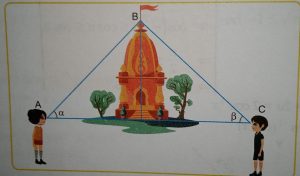Chapter 2: Miscellaneous Exercise
Find the value of the following:(Class 12 ncert solution math chapter 2 Miscellaneous)
Question 1: Find the value of ![]() .
.
Solution: ![]()
![]()
![]()
Question 2: Find the value of ![]() .
.
Solution: ![]()
![]()
![]()
![]()
![]()
Question 3: Prove that ![]() .
.
Solution: Let ![]()
Then,
![]()
Therefore,
Thus,
![]()
![]()
![]()
![]()
![]()
![]()
![]()
=R H S
Question 4: Prove that ![]() .
.
Solution: Let ![]()
Then,
Therefore,
![]()
⇒ ![]()
⇒ ![]()
Now, let ![]()
Then,
![]()
![]()
Therefore,
![]()
![]()
![]()
Thus, by using (1) and (2)
![]()
![]()
![]()
![]()
![]()
=R.H.S.
Question 5: Prove that ![]() .
.
Solution: Let ![]()
Then, Therefore,
![]()
![]()
![]()
![]() —(i)
—(i)
Now, let ![]()
Then,
Therefore,
![]()
![]()
![]()
![]() —(ii)
—(ii)
Thus, by using (1) and (2)
![]()
![]()
![]()
Now, let ![]()
Then,
![]()
Therefore,
![]()
![]()
![]()
![]()
Hence proved.
Question 6: Prove that ![]() .
.
Solution: Let ![]()
Then,
Therefore,
![]()
![]()
![]()
![]()
Now, let ![]()
Then,
Therefore,
![]()
![]()
![]()
![]()
Now, let ![]()
Then,
Therefore,
![]()
![]()
![]()
![]()
Thus, by using (1) and (2)
![]()
![]()
![]()
![]()
![]()
![]()
=R H S
Question 7: Prove that ![]() .
.
Solution: Let ![]()
Then,
Therefore,
![]()
![]()
![]()
![]()
Now, let ![]()
Then,
![]()
Therefore,
![]()
![]()
![]()
Thus, by using (1) and (2)
![]()
![]()
![]()
![]()
![]()
Question 8: Prove that ![]()
Solution:
![]()
![]()
![]()
![]()
![]()
![]()
![]()
![]()
![]()
Question 9: Prove that ![]() .
.
Solution: Let ![]()
Then,
Therefore,
![]()
![]()
Thus,
![]()
![]()
![]()
![]()
![]()
![]()
![]()
Question 10: Prove that ![]() .
.
Solution:
![]()
![]()
![]()
![]()
![]()
Thus,
![]()
![]()
![]()
Question 11: Prove that ![]()
Solution: Let ![]()
Thus,
![]()
![]()
![]()
![]()
![]()
![]()
![]()
![]()
![]()
Question 12: Prove that ![]()
Solution: ![]()
![]()
![]()
Now, let ![]()
Therefore,
![]()
![]()
![]()
![]()
Thus, by using (1) and (2)
![]()
Hence proved.
Question 13: Solve ![]() .
.
Solution: It is given that ![]()
Since, ![]()
Hence, Therefore,
![]()
![]()
![]()
![]()
![]()
![]()
![]()
Question 14: Solve ![]()
Solution: Since ![]()
Hence,
![]()
![]()
![]()
![]()
![]()
![]()
Question 15: Solve ![]() is equal to
is equal to
(A) ![]()
(B) ![]()
(C) ![]()
(D) ![]()
Solution: Let ![]()
Therefore,
![]()
Now, let ![]()
Therefore,
Hence,
![]()
Thus,
![]()
![]()
![]()
Thus, the correct option is ![]() .
.
Question 16: Solve: ![]() , then
, then ![]() is equal to
is equal to
(A) ![]()
(B) ![]()
(C) 0
(D) ![]()
Solution: It is given that ![]()
![]()
![]()
![]()
Let ![]()
Hence,
![]()
![]()
![]()
From equation (1), we have
![]()
Put ![]()
Therefore,
![]()
![]()
![]()
![]()
![]()
![]()
![]()
![]()
![]()
![]()
When ![]() , it does not satisfy the equation.
, it does not satisfy the equation.
Hence, ![]() is the only solution
is the only solution
Thus, the correct option is ![]() .
.
Question 17: Solve ![]() is equal to
is equal to
(A) ![]()
(B) ![]()
(C) ![]()
(D) ![]()
Solution: ![Rendered by QuickLaTeX.com \tan ^{-1}\left(\frac{x}{y}\right)-\tan ^{-1} \frac{x-y}{x+y} =\tan ^{-1}\left[\frac{\frac{x}{y}-\frac{x-y}{x+y}}{1+\left(\frac{x}{y}\right)\left(\frac{x-y}{x+y}\right)}\right]](https://gmath.in/wp-content/ql-cache/quicklatex.com-65b27bf11b32d07d46a8427393aaef5b_l3.png)
![Rendered by QuickLaTeX.com =\tan ^{-1}\left[\frac{\left.\frac{x(x+y)-y(x-y)}{y(x+y)}\right]}{y(x+y)}\right]](https://gmath.in/wp-content/ql-cache/quicklatex.com-c80a101ddf44d0c3bc0c47eb083aecea_l3.png)
![]()
![]()
![]()
![]()
Thus, the correct option is C.

